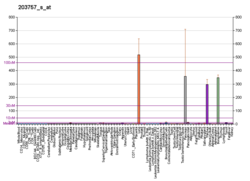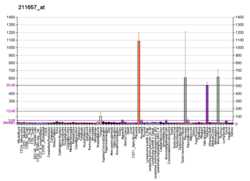CEACAM6
Appearance
(Redirected from CD66c)
Carcinoembryonic antigen-related cell adhesion molecule 6 (non-specific cross reacting antigen) (CEACAM6) also known as CD66c (Cluster of Differentiation 66c), is a member of the carcinoembryonic antigen (CEA) gene family..[3]
See also
[edit]References
[edit]- ^ a b c GRCh38: Ensembl release 89: ENSG00000086548 – Ensembl, May 2017
- ^ "Human PubMed Reference:". National Center for Biotechnology Information, U.S. National Library of Medicine.
- ^ "Entrez Gene: CEACAM6 carcinoembryonic antigen-related cell adhesion molecule 6 (non-specific cross reacting antigen)".
Further reading
[edit]- Oikawa S, Inuzuka C, Kuroki M, et al. (1991). "A specific heterotypic cell adhesion activity between members of carcinoembryonic antigen family, W272 and NCA, is mediated by N-domains". J. Biol. Chem. 266 (13): 7995–8001. doi:10.1016/S0021-9258(18)92930-3. PMID 2022629.
- Haus O, Noworolska A, Laskowski M, et al. (1990). "Prognostic significance of secondary cytogenetic changes and nonspecific cross-reacting antigen (NCA) in patients with Ph-positive chronic myeloid leukemia". Exp. Mol. Pathol. 52 (2): 235–42. doi:10.1016/0014-4800(90)90008-2. PMID 2332039.
- Hefta SA, Paxton RJ, Shively JE (1990). "Sequence and glycosylation site identity of two distinct glycoforms of nonspecific cross-reacting antigen as demonstrated by sequence analysis and fast atom bombardment mass spectrometry". J. Biol. Chem. 265 (15): 8618–26. doi:10.1016/S0021-9258(19)38932-X. PMID 2341397.
- Inazawa J, Abe T, Inoue K, et al. (1990). "Regional assignment of nonspecific cross-reacting antigen (NCA) of the CEA gene family to chromosome 19 at band q13.2". Cytogenet. Cell Genet. 52 (1–2): 28–31. doi:10.1159/000132833. PMID 2612212.
- Neumaier M, Zimmermann W, Shively L, et al. (1988). "Characterization of a cDNA clone for the nonspecific cross-reacting antigen (NCA) and a comparison of NCA and carcinoembryonic antigen". J. Biol. Chem. 263 (7): 3202–7. doi:10.1016/S0021-9258(18)69055-6. PMID 2830274.
- Kuroki M, Kuroki M, Moore GE, et al. (1988). "The molecular heterogeneity of nonspecific cross-reacting antigen synthesized by tumor cells and granulocytes". Jpn. J. Cancer Res. 79 (1): 82–90. doi:10.1111/j.1349-7006.1988.tb00014.x. PMC 5907763. PMID 3128509.
- Barnett T, Goebel SJ, Nothdurft MA, Elting JJ (1989). "Carcinoembryonic antigen family: characterization of cDNAs coding for NCA and CEA and suggestion of nonrandom sequence variation in their conserved loop-domains". Genomics. 3 (1): 59–66. doi:10.1016/0888-7543(88)90160-7. PMID 3220478.
- Tawaragi Y, Oikawa S, Matsuoka Y, et al. (1988). "Primary structure of nonspecific crossreacting antigen (NCA), a member of carcinoembryonic antigen (CEA) gene family, deduced from cDNA sequence". Biochem. Biophys. Res. Commun. 150 (1): 89–96. doi:10.1016/0006-291X(88)90490-1. PMID 3337731.
- Noworolska A, Harłozińska-Szmyrka A, Richter R (1986). "Distribution of surface nonspecific cross-reacting antigen and influence of proteolytic enzymes on this antigen in myeloid cell series". Cancer Detect. Prev. 9 (3–4): 365–71. PMID 3527416.
- Oikawa S, Kosaki G, Nakazato H (1987). "Molecular cloning of a gene for a member of carcinoembryonic antigen (CEA) gene family; signal peptide and N-terminal domain sequences of nonspecific crossreacting antigen (NCA)". Biochem. Biophys. Res. Commun. 146 (2): 464–9. doi:10.1016/0006-291X(87)90552-3. PMID 3619891.
- Watt SM, Fawcett J, Murdoch SJ, et al. (1994). "CD66 identifies the biliary glycoprotein (BGP) adhesion molecule: cloning, expression, and adhesion functions of the BGPc splice variant". Blood. 84 (1): 200–10. doi:10.1182/blood.V84.1.200.200. PMID 8018919.
- Honda Y, Egawa K, Kuroki M, Ono T (1997). "Hair cycle-dependent expression of a nonspecific cross reacting antigen (NCA)-50/90-like molecule on follicular keratinocytes". Arch. Dermatol. Res. 289 (8): 457–65. doi:10.1007/s004030050221. PMID 9266023. S2CID 8163767.
- Schölzel S, Zimmermann W, Schwarzkopf G, et al. (2000). "Carcinoembryonic Antigen Family Members CEACAM6 and CEACAM7 Are Differentially Expressed in Normal Tissues and Oppositely Deregulated in Hyperplastic Colorectal Polyps and Early Adenomas". Am. J. Pathol. 156 (2): 595–605. doi:10.1016/S0002-9440(10)64764-5. PMC 1850034. PMID 10666389.
- Oikawa S, Sugiyama M, Kuroki M, et al. (2001). "Extracellular N-domain alone can mediate specific heterophilic adhesion between members of the carcinoembryonic antigen family, CEACAM6 and CEACAM8". Biochem. Biophys. Res. Commun. 278 (3): 564–8. doi:10.1006/bbrc.2000.3858. PMID 11095950.
- Ilantzis C, DeMarte L, Screaton RA, Stanners CP (2002). "Deregulated Expression of the Human Tumor Marker CEA and CEA Family Member CEACAM6 Disrupts Tissue Architecture and Blocks Colonocyte Differentiation". Neoplasia. 4 (2): 151–63. doi:10.1038/sj.neo.7900201. PMC 1550325. PMID 11896570.
- Singer BB, Scheffrahn I, Heymann R, et al. (2002). "Carcinoembryonic antigen-related cell adhesion molecule 1 expression and signaling in human, mouse, and rat leukocytes: evidence for replacement of the short cytoplasmic domain isoform by glycosylphosphatidylinositol-linked proteins in human leukocytes". J. Immunol. 168 (10): 5139–46. doi:10.4049/jimmunol.168.10.5139. PMID 11994468.
- Skubitz KM, Campbell KD, Skubitz AP (2002). "Synthetic peptides from the N-domains of CEACAMs activate neutrophils". J. Pept. Res. 58 (6): 515–26. doi:10.1034/j.1399-3011.2001.00931.x. PMC 7162001. PMID 12005421.
- Strausberg RL, Feingold EA, Grouse LH, et al. (2003). "Generation and initial analysis of more than 15,000 full-length human and mouse cDNA sequences". Proc. Natl. Acad. Sci. U.S.A. 99 (26): 16899–903. Bibcode:2002PNAS...9916899M. doi:10.1073/pnas.242603899. PMC 139241. PMID 12477932.
- Taheri M, Saragovi HU, Stanners CP (2003). "The adhesion and differentiation-inhibitory activities of the immunoglobulin superfamily member, carcinoembryonic antigen, can be independently blocked". J. Biol. Chem. 278 (17): 14632–9. doi:10.1074/jbc.M212500200. PMID 12571231.
- Duxbury MS, Ito H, Zinner MJ, et al. (2004). "CEACAM6 gene silencing impairs anoikis resistance and in vivo metastatic ability of pancreatic adenocarcinoma cells". Oncogene. 23 (2): 465–73. doi:10.1038/sj.onc.1207036. PMID 14724575.
External links
[edit]- Human CEACAM6 genome location and CEACAM6 gene details page in the UCSC Genome Browser.
- CEACAM6+protein,+human at the U.S. National Library of Medicine Medical Subject Headings (MeSH)
This article incorporates text from the United States National Library of Medicine, which is in the public domain.




